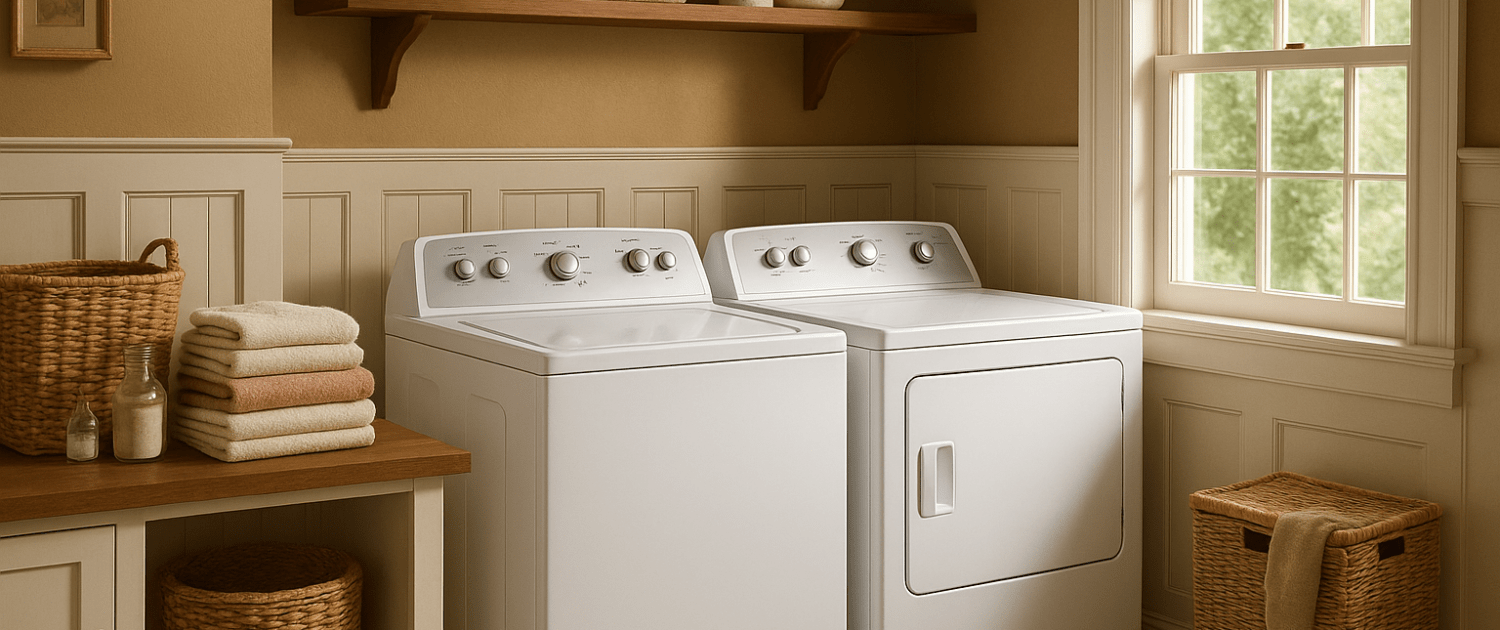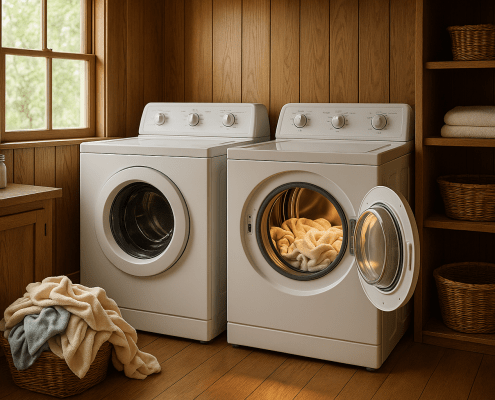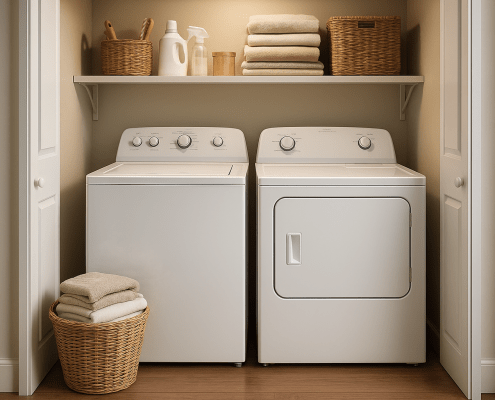How to Replace Drum Felt Seal WP33001807 in a Whirlpool Dryer
Steven E / Friday June 6, 2025
Is your dryer taking longer to dry clothes or making strange noises? The culprit might be a worn drum felt seal that lets precious heat escape. Discover how you can easily replace this essential part with our step-by-step guide and convenient how-to video just below.
Looking for the right part? Enter your appliance model number below to find the exact match and get your appliance running like new again!
The drum felt seal keeps the heated air inside your dryer, so you save energy. This soft seal made of felt goes around the edge of the metal drum housing, covering any gaps where hot air might sneak out.
With heavy use, the drum felt seal can get worn or even detach. This lets hot air escape and makes drying less effective. You might also hear weird noises like whistling or howling. Replacing a worn drum felt seal makes sure the drum is sealed tight and helps drying times.
Watch the repair here: How to install drum felt seal
The information in this article may not apply to your specific appliance model. We recommend consulting your manufacturer’s documentation or contact us with any questions.
Tools and materials needed
Gather the following tools and supplies before disassembling the dryer:
- Needle nose pliers
- Flat blade screwdriver
- Phillips head screwdriver
- 5/16-inch nut driver
- 1/4-inch nut driver
- Replacement drum felt seal (part #WP33001807)-Take your model number to AppliancePartsPros.com to locate the correct part for your unit.
Safety first
When working on any appliance, always keep safety first to avoid personal injury or damage to the appliance or parts. Here are some safety tips to keep in mind:
- Always power off and unplug your appliance or switch off the circuit breaker before attempting any maintenance or replacement work. This keeps you safe by preventing any risk of electric shock.
- If you have a gas unit, turn off the gas to the appliance
- If the appliance has recently been used, give it plenty of time to cool down before working on it.
- Take your time and don’t rush while working to prevent accidents and personal injuries.
- Work in a well-lit area so you can clearly see and access appliance parts.
- Keep your workspace free of clutter and other obstacles. Keep children and pets away from the work area.
- Never work on internal parts with wet hands. Make sure the work area is completely dry.
- Check the user manual to see if there are specific installation or safety instructions related to your appliance or replacement part.
- Be gentle when handling or removing parts. Excessive force might damage the appliance or cause personal injury.
- Wear insulated work gloves to protect your hands from sharp metal parts and debris.
- When working with wires, avoid touching any exposed wires or terminals. If you need to touch a wire, use a non-conductive tool or wear insulating gloves to prevent electrical shock.
- Consider wearing safety glasses and/or a dust mask when working with chemicals, dust or a large amount of debris to prevent irritation or injury.
Step 1: Remove the door and front panel
- Open the dryer door and locate the two screws that hold the front panel on. Remove both screws using a Phillips head screwdriver.
- Use the Phillips head screwdriver to remove the screws securing the door hinges.
- Lift up slightly on the door to release the hinges from their catch. Remove the full door assembly and set it aside.
- Firmly grip the edges of the front panel near the top corners and pull straight outward. This will disengage the retention clips holding it in place. Tilt the panel forward to remove it completely.
Avoid prying hard against or bending panels to prevent cosmetic damage.
Step 2: Detach the top panel and drum housing
Before fully reaching the drum seal area, some disassembly is still required:
- Use a 5/16-inch nut driver to remove the 2 screws that hold the brackets that retain the top panel of the dryer.
- Tilt back the top panel assembly
- Remove 2 of the 3 screws on each side that hold the front panel assembly in place. DO NOT remove the 2 screws located in the cut-out area.
- Tilt down the panel to access the wiring for the door switch.
- Note the orientation of the wires. You can also take a picture for reference later. Remove the wiring harness from the switch and set the front panel aside.
- Remove the 2 remaining 5/16-inch screws and pull off the front bearing assembly.
Step 3- Remove the worn drum felt seal
- The current felt seal can be seen wrapped around the outer metal drum housing, and overlapping ends along the top.
- Grab the flat head screwdriver and carefully pry and lift up the metal locking tabs.
- With all tabs loosened, grab the felt seal firmly and peel it downward off the metal housing, working your way around the complete perimeter.
Step 4- Install the new replacement felt seal
- Align the end of the new felt seal across the top of the metal housing, and tuck the seal under the tabs all the way around.
- Using a screwdriver, press firmly, and fold the metal locking tabs back down over the top edge of the seal, creasing the felt around its entire circumference.
- Meet back around at the other end, make sure one side covers over the top edge. This prevents the seal from unwinding over time as the dryer operates.
Step 5- Reassemble the dryer cabinet and controls
- Carefully tilt the front bearing support assembly back into position, tucking the new seal over the top of the drum assembly.
- Reinstall the two front drum housing screws using a 5/16-inch nut driver and tighten down completely.
- Reconnect the door switch wiring harness according to its original layout. Check your notes or pictures to place them back properly. Improper electrical connections can prevent the dryer from powering on.
- Hold the front panel loosely in place and insert the lower two retaining screws along its bottom edge first. Then install the upper two screws.
- Swing the top panel back down flush to the cabinet and reinstall the two metal brackets with their mounting screws.
- Reinstall the front panel. Position the slots on the bottom of the panel with the 2 alignment tabs on the bottom of the dryer cabinet.
- Push in the top portion of the panel that is held in by retaining clips.
- Use the Phillips head screwdriver to install the 2 door alignment tabs.
- Align the door assembly hinges with their wall brackets. Insert and tighten the two Phillips head screws.
- Give the door latch a test from the outside to ensure proper closure and alignment. Carefully realign if the latch fails to engage smoothly.
- Finally, confirm the power cord is plugged firmly into the electrical outlet, then restore power to the dryer at the circuit breaker.
Test and verify repair
- Turn on the dryer and run a test cycle, letting it heat up completely. Keep a close eye and ear out during the first run after the work was done, checking for any leaks.
- As the dryer heats up, make sure to take a close look around the door, exhaust duct, and rear vents for any unusual airflow or loud whistling. These could be signs of leaks that allow heated air to escape from the drum housing.
- Once you’ve confirmed everything is running smoothly and there are no leaks, just let the full test cycle finish. You shouldn’t have any problems getting things dried properly.
- Try out the new drum felt with different load sizes and fabric types. Keep an eye on how it performs from time to time.
More Information
Thanks for reading! We hope this article helped you replace the drum felt seal in your Whirlpool, KitchenAid or Maytag dryer.
If you still need some replacement parts, grab your model number and head over to AppliancePartsPros.com. We offer over two million parts and most orders arrive in two business days. If you need some help with finding the right part or placing an order, you can contact our team at 1 (877) 477-7278.
While you’re waiting for your new part to arrive, you can explore our DIY blog and watch thousands of video tutorials on our YouTube channel.
Be sure to follow us on Facebook, Twitter, and Instagram to see our latest repair guides!
With nearly a decade of experience in providing top-notch customer service regarding appliance parts and repair, Steven enjoys sharing practical advice, troubleshooting tips, and interesting information to help readers stay informed.





